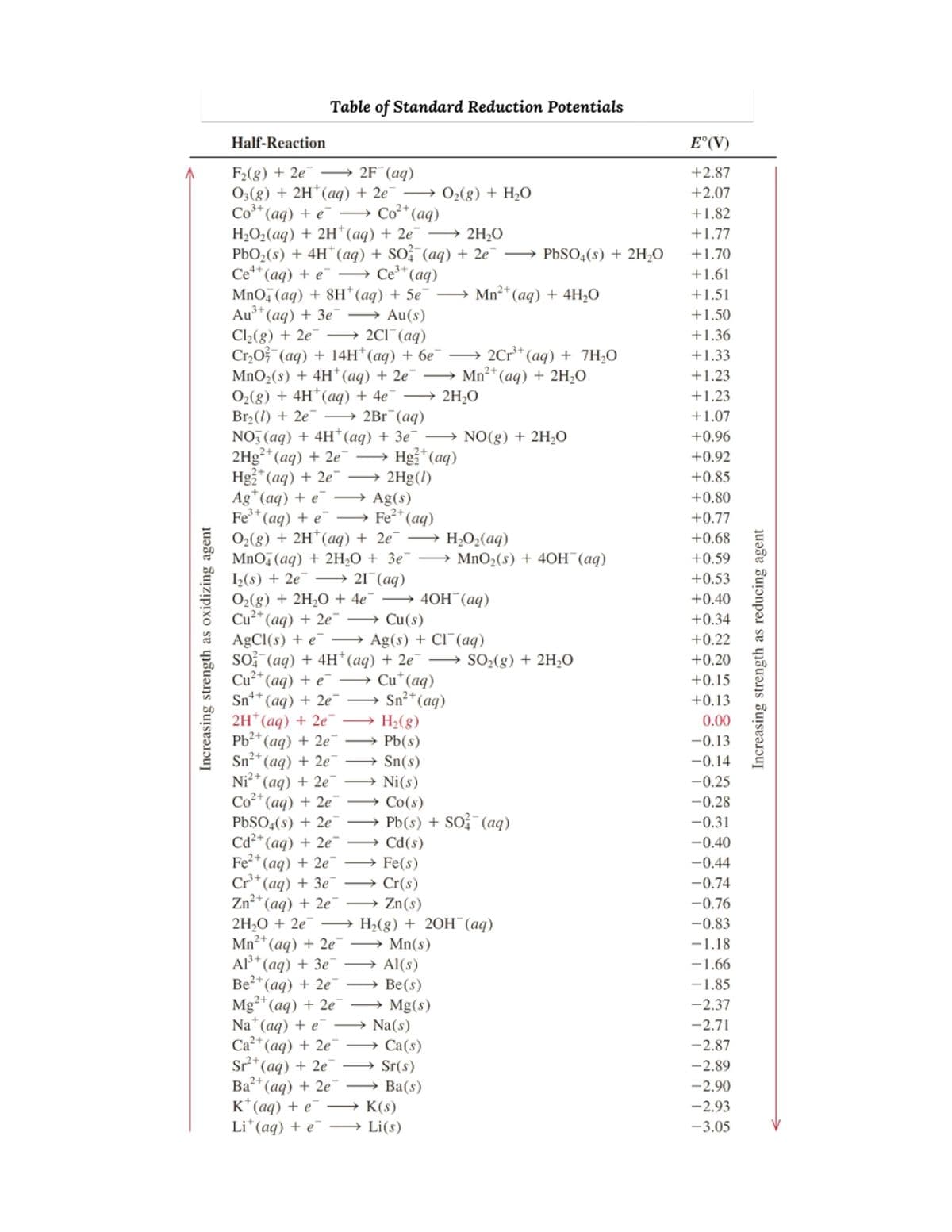Based on the galvanic cell formed by following cell reaction (assuming all concentrations are 1.0 M): 2Cu²+ (aq) + Co(s) → 2Cu¹(aq) + Co²+ (aq) a. Write the cell diagram. b. What will be the Eᵒcell? Show solution (use provided SRP table values).
Based on the galvanic cell formed by following cell reaction (assuming all concentrations are 1.0 M): 2Cu²+ (aq) + Co(s) → 2Cu¹(aq) + Co²+ (aq) a. Write the cell diagram. b. What will be the Eᵒcell? Show solution (use provided SRP table values).
Chapter18: Electrochemistry
Section: Chapter Questions
Problem 153CP: Consider the following galvanic cell: A 15 0-mole sample of NH is added to the Ag compartment...
Related questions
Question

Transcribed Image Text:Based on the galvanic cell formed by following cell reaction (assuming all concentrations are 1.0 M):
2Cu²+ (aq) + Co(s) → 2Cu¹(aq) + Co²+ (aq)
a.
Write the cell diagram.
b. What will be the Eᵒcell? Show solution (use provided SRP table values).

Transcribed Image Text:Increasing strength as oxidizing agent
Table of Standard Reduction Potentials
Half-Reaction
F₂(g) + 2e2F (aq)
03(g) + 2H+ (aq) + 2e¯ →→ O₂(g) + H₂O
Co³+ (aq) + e-
Co²+ (aq)
H₂O₂(aq) + 2H(aq) + 2e¯→→→→→→ 2H₂O
PbO₂ (s) + 4H+ (aq) + SO (aq) + 2e
+ (aq) + e Ce³+ (aq)
Ce4+
MnO4 (aq) + 8H*(aq) + 5e¯ →→Mn²+ (aq) + 4H₂O
Au³+ (aq) + 3e →→→ Au(s)
2Cr³+ (aq) + 7H₂O
Mn²+ (aq) + 2H₂O
Cl₂(g) + 2e →→→ 2Cl¯ (aq)
Cr₂O (aq) + 14H+ (aq) + 6e¯
MnO₂ (s) + 4H+ (aq) + 2e¯→→
O₂(g) + 4H(aq) + 4e¯ →
Br₂(1) + 2e2Br (aq)
NO3(aq) + 4H+ (aq) + 3e
2Hg²+ (aq) + 2e
NO(g) + 2H₂O
Hg₂+ (aq)
Hg2+ (aq) + 2e →→→ 2Hg(1)
Ag+ (aq) + e Ag(s)
Fe³+ (aq) + e→→→→→→ Fe²+ (aq)
O₂(g) + 2H+ (aq) + 2e →
H₂O₂(aq)
MnO₂ (s) + 4OH(aq)
MnO4 (aq) + 2H₂O + 3e¯
1₂(s) + 2e21 (aq)
O₂(g) + 2H₂O + 4e4OH(aq)
Cu²+ (aq) + 2e
Cu(s)
AgCl(s) + e
Ag(s) + Cl(aq)
SO (aq) + 4H+ (aq) + 2e →→→ SO₂(g) + 2H₂O
Cu²+ (aq) + e
Cu* (aq)
Sn4+
4+ (aq) + 2e¯
Sn²+ (aq)
H₂(g)
2H*(aq) + 2e
Pb²+ (aq) + 2e
Pb(s)
2+
Sn²+ (aq) + 2e
Sn(s)
Ni(s)
Ni²+ (aq) + 2e
Co²+
→Co(s)
(aq) + 2e¯
PbSO4(s) + 2e
Pb(s) + SO² (aq)
Cd(s)
Cd²+ (aq) + 2e
Fe²+ (aq) + 2e
→Fe(s)
Cr³+ (aq) + 3e
→ Cr(s)
Zn²+
(aq) + 2e¯¯→→→→→→ Zn(s)
2H₂O + 2e →→→ H₂(g) + 2OH(aq)
Mn²+ (aq) + 2e
→ Mn(s)
Al³+ (aq) + 3e
Al(s)
Be(s)
→ Mg(s)
Be²+ (aq) + 2e
Mg²+ (aq) + 2e
Na (aq) + e
Ca²+ (aq) + 2e
Na(s)
Ca(s)
Sr2²+ (aq) + 2e
Sr(s)
2+
Ba²+ (aq) + 2e →→→ Ba(s)
K+ (aq) + e → K(s)
Li (aq) +eLi(s)
2H₂O
PbSO4(s) + 2H₂O
E° (V)
+2.87
+2.07
+1.82
+1.77
+1.70
+1.61
+1.51
+1.50
+1.36
+1.33
+1.23
+1.23
+1.07
+0.96
+0.92
+0.85
+0.80
+0.77
+0.68
+0.59
+0.53
+0.40
+0.34
+0.22
+0.20
+0.15
+0.13
0.00
-0.13
-0.14
-0.25
-0.28
-0.31
-0.40
-0.44
-0.74
-0.76
-0.83
-1.18
-1.66
-1.85
-2.37
-2.71
-2.87
-2.89
-2.90
-2.93
-3.05
Increasing strength as reducing agent
Expert Solution
This question has been solved!
Explore an expertly crafted, step-by-step solution for a thorough understanding of key concepts.
Step by step
Solved in 4 steps with 1 images

Knowledge Booster
Learn more about
Need a deep-dive on the concept behind this application? Look no further. Learn more about this topic, chemistry and related others by exploring similar questions and additional content below.Recommended textbooks for you


Chemistry
Chemistry
ISBN:
9781305957404
Author:
Steven S. Zumdahl, Susan A. Zumdahl, Donald J. DeCoste
Publisher:
Cengage Learning

Chemistry: An Atoms First Approach
Chemistry
ISBN:
9781305079243
Author:
Steven S. Zumdahl, Susan A. Zumdahl
Publisher:
Cengage Learning


Chemistry
Chemistry
ISBN:
9781305957404
Author:
Steven S. Zumdahl, Susan A. Zumdahl, Donald J. DeCoste
Publisher:
Cengage Learning

Chemistry: An Atoms First Approach
Chemistry
ISBN:
9781305079243
Author:
Steven S. Zumdahl, Susan A. Zumdahl
Publisher:
Cengage Learning

Chemistry: The Molecular Science
Chemistry
ISBN:
9781285199047
Author:
John W. Moore, Conrad L. Stanitski
Publisher:
Cengage Learning

Chemistry & Chemical Reactivity
Chemistry
ISBN:
9781337399074
Author:
John C. Kotz, Paul M. Treichel, John Townsend, David Treichel
Publisher:
Cengage Learning

Chemistry & Chemical Reactivity
Chemistry
ISBN:
9781133949640
Author:
John C. Kotz, Paul M. Treichel, John Townsend, David Treichel
Publisher:
Cengage Learning